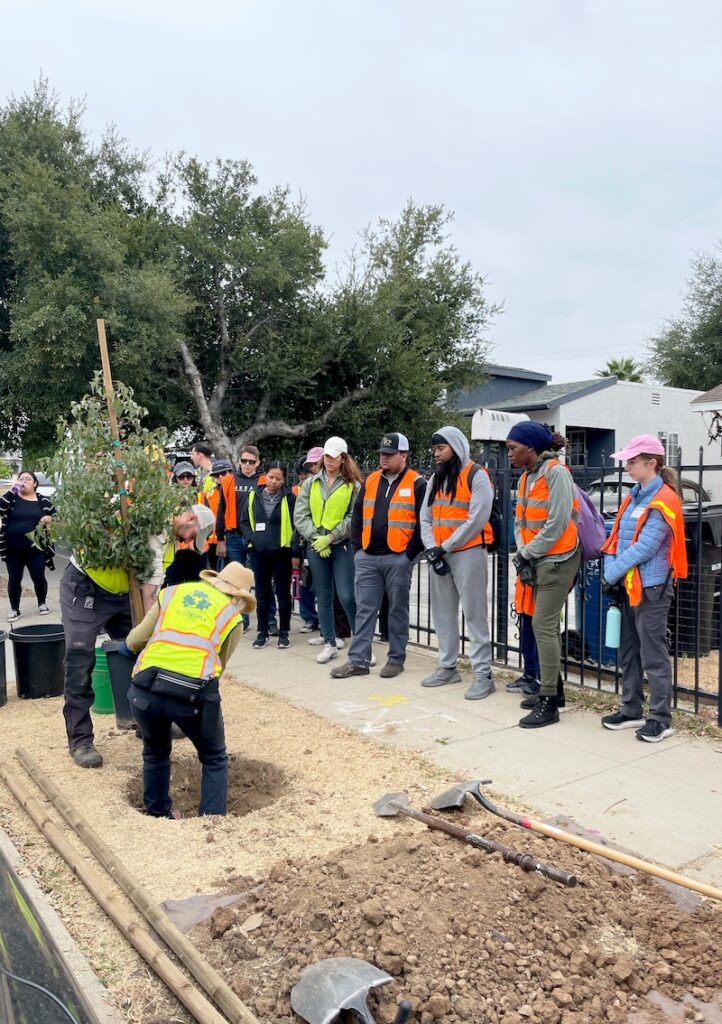Above: TreePeople volunteers work together to dig a hole for a new tree in San Fernando, Calif. (Photo by Sophie Craypo.)
SAN FERNANDO, Calif. — On an overcast Saturday morning in the San Fernando Valley, dozens of volunteers in bright yellow and orange construction vests linked hands, forming a semicircle around a newly planted tree on a quiet residential street.
“Trees need people, people need trees, welcome Pam,” the group chanted together.
They named the tree in honor of Pam Gibson, who spent 17 years as the regional manager with the San Fernando Valley non-profit TreePeople, which organized the day’s planting and training event in a residential neighborhood adjacent to Pioneer Park in the city of San Fernando.
After the naming ceremony, volunteers gathered their tools and split up into groups, dispersed along a two-block stretch, ready to plant their own trees and put into action the crash course they had just received on proper planting hole dimensions, berm building, staking, and watering.
By midday, 14 trees were planted as part of a “calles verdes” – green streets – initiative run by TreePeople, which has been working for more than 50 years on forestry, schoolyard greening, land stewardship, education, and urban greening policy in Southern California.
With funding from the Bezos Earth Fund’s Greening America’s Cities initiative, the organization plans to plant more than 4,250 trees as a front line of defense against climate change, an opportunity for workforce development, and as a catalyst for other environmental justice work in the neighborhoods that most need greening. These are often low-income Latino communities like San Fernando.

“The big piece is planting trees in communities that historically have had low tree canopy and have been exposed to environmental burdens that often go along with that, such as extreme heat, flooding, and drought,” said David Pineda, TreePeople’s senior director of strategy and impact.
“Tree canopy in Los Angeles in particular is very much a function of income and whether you belong to a minority group,” he added. “We want to get a lot more trees in the ground and do so in a manner that is receptive to what the community wants to see, using trees as a vehicle to engage folks.”
TreePeople currently runs urban forestry projects in South L.A., the San Gabriel Valley, and the Inland Empire, in addition to the Northeast San Fernando Valley. Each of these locations was selected through a need-based and community-oriented approach.
TreePeople works with residents to identify where they want to see trees – whether it is around schools, in their neighborhoods, or at parks – and collaborates with local agencies to get the proper permitting and permission to plant. The organization aims to create lasting place-based approaches with a local team. Cultivating long-lasting relationships and community investment comes naturally with tree care, they say.

“It’s important that we maintain all the trees that we plant,” said Bryan Vejar, TreePeople’s associate director of community forestry at the recent planting workshop. “So, we communicated with the residents to ensure that they are able to adopt the tree and water it once or twice a week for the first three years.”
One of the biggest benefits of tree planting will come as these new trees mature and create a canopy providing shade to mitigate extreme heat. With global warming causing average temperatures to rise, creating shade in communities that suffer from extreme heat is essential, said Mary Sloan, a Tree People volunteer since 2021, when she began planting trees in Malibu after a major wildfire.
“Tree planting is important because it really does cool the environment,” Sloan said. “It’s the ground that radiates the most heat, and with more shade coverage, the less intense that is going to be.”
TreePeople has adapted their tree planting strategies for climate change, selecting native and drought tolerant species that are appropriate for warmer and drier climates. However, climate related challenges still arise.
“Even if we’re making sure trees are irrigated and cared for, there can be a week in there that is just extremely hot triple digit weather, and the shock of that is impacting trees,” said Marcos Trinidad, the organization’s senior director of programs. “They immediately get burnt, and sometimes they can’t react quick enough.”
These initiatives are about more than just planting trees, said Trinidad. They are also about community engagement and organizing that can lead to other important benefits.
“You’re able to give the community a victory that’s attainable,” he said. “It has a direct impact. You can go through this process, plant trees, and experience your victory every day. That allows us to gain some air under our wings and then start having these bigger conversations.”
Many volunteers shared the sentiment that planting trees can empower and inspire future generations.
“I hope to bring my son to future events so he can see the importance of trees in our neighborhoods,” said Evelyn Pelen, a Pierce College student who came to the tree planting event with her arboriculture class.
As volunteer Mary Sloane guided her other group members in lowering a tree into its newly dug hole, she reflected, “Reforesting a forest is like building a cathedral. The first generation that starts isn’t going to see the results, but their grandchildren probably are. It’s for the rest of their family and whoever comes after them.”
The power of TreePeople’s community-driven and grassroots approach to bring new people to care for trees became clear about halfway through the morning.
As volunteers drove stakes into the soil to support their trees as they grow, a car passing by slowed down. The driver leaned out the window, admiring the scene, and asked how she could sign up to have trees planted on her block.
This story was produced by Ethnic Media Services in collaboration with the Laboratory for Environmental Narrative Strategies (LENS) at UCLA as part of the Greening American Cities initiative supported by the Bezos Earth Fund.




